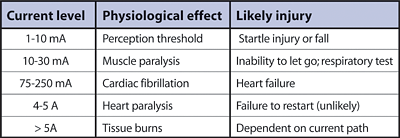
These types of activities, as well as simply being present on job sites where electrical hazards may exist, dictate that we have basic safety training that permits us to recognize and avoid hazardous situations. This column will not to try to provide that training, but to make the case for it by describing some of the hazards and associated regulations that you should be aware of. We'll start this month by discussing "plain old" electrocution, and in the next column I'll address the newer (from a regulatory standpoint) issue of arc flash hazards.
More Than Shocking
Most people think of electrical hazards primarily in terms of electric shock and the related cardiac failure that can occur from prolonged contact with 120 V alternating current circuits. These low currents are measured in milliamperes (mA) rather than amperes, and their physiological effect can vary with the individual. Table 1 shows effects of varying levels of shock on a typical 68 kg person. Currents in the range of 75 to 250 mA, taking a path through the heart, may induce cardiac fibrillation by interfering with the normal electrical nerve activity which regulates the heartbeat. For most of us, for whom electrocution is most likely to occur at home, this is our primary risk.When you are in a large facility or on a construction site, however, it's an entirely different matter. Low-level shock hazards still exist, but exposure to voltages of 480V and above can produce higher levels of current that can burn the tissues they pass through. Extent of injury in these instances depends on the path the current takes through the body and the duration of contact. If vital organs are involved, these burns may be fatal; if not, they can still result in extensive muscle damage.
Current follows the least-resistance path of muscles, blood vessels and nerves, often leaving only minor entry and exit wounds while causing extensive internal damage. For contact at primary voltage (over 600V), burns are almost the exclusive cause of injury and death and, as we'll see in the next column, electric arcing can "reach out and touch you" causing severe burns without any contact.


